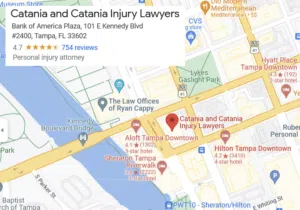
Quadriplegia or tetraplegia happens when a spinal cord injury causes partial or total paralysis in your arms and legs. People sometimes refer to quadriplegia as “paralysis from the neck down.”
Quadriplegia can cause permanent or temporary paralysis. In some cases, some nerves remain intact, allowing the brain to reroute nerve signals. But in many cases, quadriplegia will result in permanent disability.
Here is some information about a quadriplegia injury and the compensation you can seek for it.
Table of Contents
How Does a Quadriplegia Injury Happen?
The spinal cord carries nerve signals between the brain and body. Control signals and motor commands run from the brain to the muscles and organs. Sensory signals run from the body to the brain.
Nerves consist of neurons that communicate using electric charges. When the nerves of the spinal cord get damaged, the signals get interrupted or disrupted. A severed nerve cannot transmit at all.
What Are the Causes of Quadriplegia Injuries?
The spine protects the spinal cord. Each vertebra of the spine includes a cylindrical body and wing-shaped processes.
The gap between the body and the processes forms the spinal canal. The spinal cord runs through the spinal canal.
Nerve roots branch out from the spinal cord at each vertebra. These nerve roots connect the peripheral nerves throughout the body to the spinal cord. The lower branches run to the abdomen, hips, legs, and feet. The upper branches run to the chest, shoulders, arms, and hands.
When the spinal cord gets severed, the severed nerves lose their electrical connection to the brain. The spinal cord can get severed in a few ways, including:
Dislocated Vertebra
If your accident fractures a vertebral process or tears the ligaments that hold a vertebra in place, the vertebra can dislocate and sever the nerves in the spinal cord.
Fractured Vertebra
A fractured vertebra does not need to dislocate to sever the spinal cord. Bone fragments from a fracture can move into the spinal canal and sever nerves.
Foreign Object
A foreign object in the spinal canal can sever nerves. For example, if you fall onto a tool or a piece of building material in a construction accident, the object can penetrate your spine and sever the spinal cord.
What’s the Difference Between Complete and Incomplete Quadriplegia Injuries?
Paralysis happens when nerves get severed. Most areas of your body have an entire network of nerves. An injury could sever some or all of the nerves.
The American Spinal Injury Association rates spinal cord injuries using a five-level scale:
- Complete quadriplegia
- Some sensory function, no motor function
- Some sensory and motor function but fewer than half of muscle groups can move against gravity
- Some sensory and motor function and more than half of muscle groups can move against gravity
- Normal sensory and motor function
Complete quadriplegia happens when all nerves connecting your body and brain get severed. In complete quadriplegia, you have no sensory or motor function below the spinal cord injury.
Incomplete quadriplegia happens when some nerves connecting your body and brain remain. In incomplete quadriplegia, your body might retain some sensory and motor connections.
What Are the Side Effects of a Quadriplegia Injury?
The vertebrae of the neck are numbered C1 through C7. C1 is the highest vertebrae located at the base of the skull. The effects of quadriplegia injury depend on where your spinal cord injury happened.
C1 through C3
An injury at C1 through C3 often causes death. The nerves that control the diaphragm and chest muscles branch from these vertebrae.
When an accident severs these nerves, you cannot breathe without a ventilator or other respiratory assist device. If your brain cannot get oxygen for just four minutes, you run a high risk of brain damage, coma, or death.
Accident victims who survive an injury at C1 through C3 will often have total paralysis below the injury and will require assistance to breathe.
C4
An injury at C4 will usually cause quadriplegia. This vertebra is high enough that it carries the nerves running to all four limbs, the chest, and the abdomen.
But some of the nerves running to the muscles that control breathing have branched off. As a result, some, but not all, accident victims with a C4 injury will need breathing assistance.
A C4 injury might also affect the patient’s ability to control their vocal cords and swallow.
C5
As you move down the cervical spine to C5, the accident victim might retain more control over the muscles in the neck and shoulders. A complete injury at C5 will still paralyze the body below the shoulders, as well as your arms, hands, and fingers.
Some accident victims with a C5 injury may breathe, speak, and swallow without assistance. Others will have difficulties with some or all of these tasks.
C6 and C7
Injuries at the C6 and C7 vertebrae rarely cause complete quadriplegia. They will usually paralyze the hands, abdomen, hips, and legs. However, they are less likely to paralyze the chest, shoulders, and arms.
What Are the Risk Factors for a Quadriplegia Injury?
Quadriplegia can result from accidents, violence, or even disease. But over 60% of quadriplegia cases result from two types of accidents:
Car Accidents
Car accidents cause 42% of quadriplegia cases. Car accidents involve some unique physics that cause back and neck injuries.
As you collide with another car, your head keeps moving while your seatbelt restrains your body. As a result, your neck hyperextends.
As it rebounds, the force can fracture vertebrae, compress discs, and stretch ligaments. The damage to the neck can cause vertebrae to dislocate or fracture, leading to quadriplegia.
Falls
Whether they happen in a workplace accident, a slip and fall accident, or a sports-related accident, falls put enormous strain on your neck. Falls account for 22% of quadriplegia cases.
What Compensation Can I Recover for a Quadriplegia Injury?
Quadriplegia injuries can devastate your life. You might face a lifetime of medical treatment, physical and mental health therapy, and medication. You may need to retire from work due to your physical limitations.
Your compensation after a quadriplegia injury caused by someone else’s negligence can also account for your medical expenses, lost income, and diminished earning capacity.
You can also claim compensation for the diminishment in your quality of life. Some examples of these kinds of damages include physical pain, mental anguish, and loss of activities. For example, if you’re no longer able to take walks for your spouse, it may affect your compensation.
Contact a Tampa Personal Injury Lawyer for Help
To discuss the compensation you can recover for your quadriplegia injury, contact Catania and Catania Injury Lawyers for a free consultation. Our Tampa personal injury lawyers are here to help.




